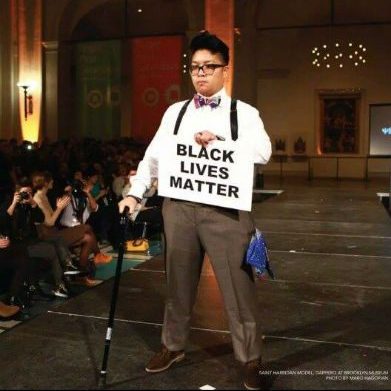DapperQ.com
I put on my first pair of men’s underwear as a joke. My Bible College volleyball team stole our coach’s tighty whities from his home while we were dog-sitting and then each wore a pair to our next practice. Under our practice clothes. I forgot how we did the big reveal, but we thought we were very hilarious and, as I recall, ended up running many many wind sprints that day.
What began as a joke became part of my regular wardrobe. In fact, I wore men’s underwear for a half dozen years before I came out as queer. Once when I was going to be in the hospital, a friend asked if it would be a better idea for me to wear something more gender binary appropriate. I thought for a minute. As a butch woman, men’s underwear feels like armor to me. I wanted to work all the confidence I could underneath my ass-baring hospital gown. I stuck with my men’s briefs.
What I had experienced anecdotally is actually a researched phenomenon. Anita Dolce Vita, a nurse and managing editor at DapperQ.com wrote about this for Disruptive Women in Health Care:
“We know that clothing is a language and that we make assumptions about people based on what they wear. And, we see how this phenomenon can result in poor health. But, to take it a step further, a new scientific field known as embodied cognition has been looking at how our clothing impacts our cognitive processes. Research shows that our clothing can affect how well we perform on certain tasks. These findings are very relevant to our [DapperQ.com} readers, many of whom express experiencing major anxiety when they feel forced to dress in a manner that does not affirm their gender identity.”
DapperQ.com recently produced one of the world’s largest gender-queer fashion shows in association with Brooklyn Museum’s Target First Saturdays. I asked Susan Herr, Dapper Q’s founder what she thought the message of the intersection between fashion and health might be. She responded:
“When I was growing up, my mama always said, ‘You slouch, you’ll get stuck that way.’ Great advice unless you’re a baby butch born with natural swagger in the great state of Texas. I survived adolescence by learning to lay low. I launched dapperQ five years ago to build community with brethren who could help me lift my head. Does the self-acceptance I found here make me a healthier person? Damn straight it does.”
Cameron Varney, an LA based model who walked the runway for Sharpe Suiting, echoed a similar sentiment about the fashion/health connection:
“Wearing perfectly tailored clothes affords me the confidence that literally makes me stand up taller and have better posture. It is a simple way I can connect my mind and my body.”
.jpg)
Performer Kay Ulanday Barrett modeled for Saint Harridan in the show and later explained why it was important to participate:
“In mainstream, I’m told that being pudgy, brown, disabled, trans, I’m told those aren’t desirable. I’m told I don’t exist. That’s kills people like me everyday. However, when I have options to engage my dapper, I’m drawing from my style, my influences & interpretations, I can be my authentic self. Some people say, that’s just a shirt or hat, what they don’t get is that shirt has utility. It brings my community & i closer to comfort, closer to the love work we connect to…
The messaging I’ve received as a queer boi is clear: able bodied, white, skinny, & american bodies are the standard. I counter that standard with my patterned bow tie, beads, cane. With tools & clothing that honor me, I channel my own brand. I harness the art of communities that embody a style that pays no mind to the rules. We can alter the rules….In fashion, in lesbian & gay spaces, my brown bois, migrant bois, femme bois, fat bois, sick & crip bois aren’t celebrated. Being on that runway, wearing apparel that reflects me for just 2 minutes can change the image of fashion, and by proxy celebrate all our complex gorgeous selves.”
For other masculine of center folks, the footwear makes a difference. Linda Saegert said ” For me, it is shoes, when I look at my feet and see a pair of good MENS shoes that fit me perfectly I feel really good” and Kathleen Schlagel added to this: “I hate wearing a bra but do not have the patience to bind. All of my clothing is from the “menswear” side of the store. As long as I am wearing a pair of Kenneth Cole shoes I can get past any issues with fit.”
The connection between looking good and feeling good isn’t so much about brand or specific gender, but more about access to fashion that fits our inner selves and well as our outer selves. As blogger and event producer Bevin Branlandingham explained “For me, coming out as femme and aligning my clothing on the outside of my body to be what I felt on the inside was a huge part of my liberation as a fat person. I was taught that fat should be hidden and as a lesbian I wouldn’t get dates if I presented as a feminine person, so I just swam in clothes too big for me. Dressing how I like to dress has been a huge part of my body love journey. Loving myself has helped me become more in touch with what my body wants and needs. Style has had a profound impact on that.”
Or as Heather Batson summed it up so succinctly: “When I’m wearing clothes that don’t fit my body and my gender, i feel furious and alienated from myself.”
